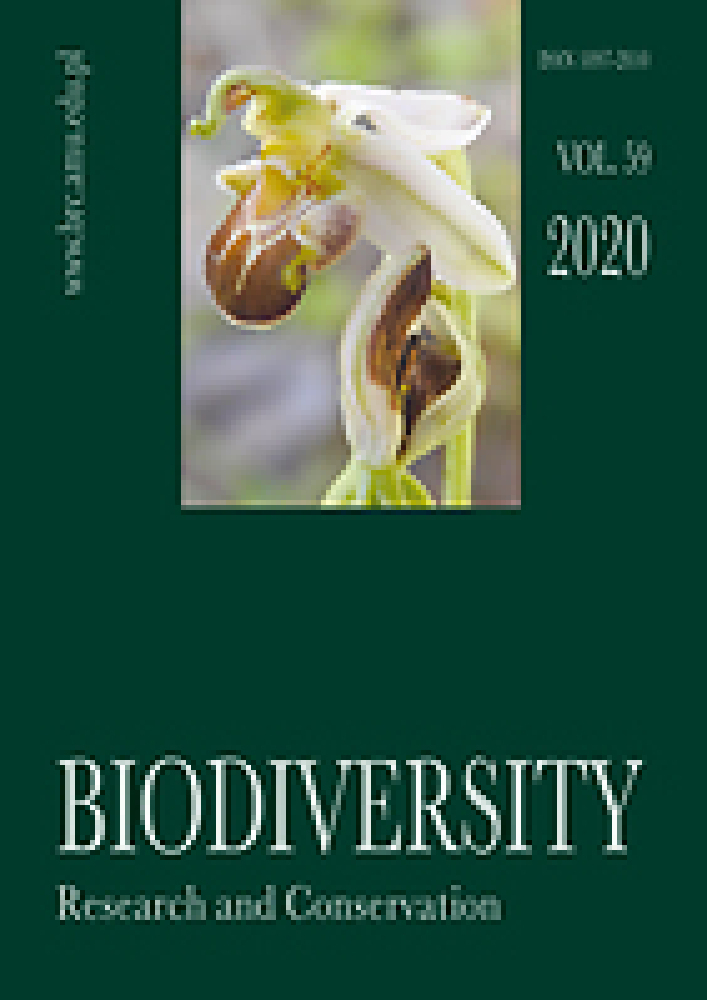Abstract
A new locality of regionally alien and rare Virga pilosa was recorded outside the compact range of the species in the Wielkopolski National Park, midwestern Poland. It probably appeared as a result of unintentional anthropochory. Local distribution pattern of V. pilosa in micro- and mesoscale was described and interpreted in the light of life and dispersal strategy and habitat conditions of the species. Accidental epizoochory and unintentional anthropochory could have been responsible for the mesoscale distribution pattern with population units scattered along human and animal communication routes. Close dense autochory together with the species CR life strategy with a strong competitive component were responsible for microscale distribution pattern alternating in space and time, but always mosaic, including vegetative, generative and mixed patches. The distribution pattern was also influenced by the occurrence of the required combination of the moderately light, moderately moist and nitrogen-rich habitat conditions with favourable human-induced disturbance. Some data on the form of growth, reproductive potential and dispersal mode of the species, as well as on plant-animal interactions were also included.
References
BDL 2020. Bank Danych o Lasach [Forest Data Bank].https://blog.haveabook.eu/post/semantic-html-what-it-is-and-why-it-matters-in-ebooks bdl. lasy.gov.pl/portal/mapy [access: 28.11.2020]
Borowiec S. 1973. Związki między glebami i zespołami roślinnymi w Wielkopolskim Parku Narodowym. Szczecińskie Tow. Nauk., Wydz. Nauk Przyr.-Roln. 38(1): 1-52.
Braun-Blanquet J. 1964. Pflanzensoziologie. Grundzüge der Vegetationskunde. 631 pp. Springer, Wien-New York.
Faliński J. B. 1968. Stadia neofityzmu i stosunek neofitów do innych komponentów zbiorowiska. Materiały Zakładu Fitosocjologii Stosowanej UW 25: 15-31.
Frey L. & Frey W. 2014. Nowe stanowisko Virga pilosa (Dipsacaceae) w Beskidzie Sądeckim (S Polska). Fragm. Flor. Geobot. Polonica 21(2): 399-401.
Grime J. P. 1974. Vegetation classification by reference to strategies. Nature 250: 26-31.
Grime J. P. 2002. Plant strategies, vegetation processes and ecosystem properties. 2nd ed. 417 pp. John Wiley & Sons, Ltd.
Jaźwa M. & Stadnicka-Futoma A. 2017. Flora roślin naczyniowych Podgórza Rzeszowskiego. 453 pp. PAN – Kom. Bot. Organizm. IB UJ, Warszawa-Kraków.
Bräutigam S. 2017. Dipsacaceae Juss. – Kardengewächse. In: E. J. Jäger (ed.). Rothmaler – Exkursionsflora von Deutschland. Gefäßpflanzen: Grundband, 21 edition, pp. 759-762. Springer Spektrum, Berlin.
Klotz S. & Kühn I. 2002. Ökologische Strategietypen. In: S. Klotz, I. Kühn & W. Durka (eds). BIOLFLOR: Eine Datenbank mit biologisch-ökologischen Merkmalen der Gefäßpflanzen in Deutschland, pp. 197-201. Bundesamt für Naturschutz, Bonn-Bad Godesberg.
Kornaś J. 1981. Oddziaływanie człowieka na florę: mechanizmy i konsekwencje. Wiad. Bot. 25(3): 165-182.
Matuszkiewicz J. M. 2008. Potencjalna roślinność naturalna Polski. IGiPZ PAN, Warszawa. https://www.igipz.pan.pl/tl_files/igipz/ZGiK/opracowania/roslinnosc_potencjalna/prn_opracowanie.pdf [access 14.12.2020]
Mayer V. 2016. Dipsacaceae (inclusive Triplostegia). In: J. Kadereit & V. Bittrich (eds). Flowering Plants. Eudicots. Aquifoliales, Boraginales, Bruniales, Dipsacales, Escalloniales, Garryales, Paracryphiales, Solanales (except Convolvulaceae), Icacinaceae, Metteniusaceae, Vahliaceae. The Families and Genera of Vascular Plants 14, pp. 145-163. Springer, Cham. https://doi.org/10.1007/978-3-319-28534-4_11
Meusel H. & Jäger E. J. (eds). 1992. Vergleichende Chorologie der zentraleuropäischen Flora. III. Text ix+333 pp., Karten, Literatur, Register pp. ix+422-688. Gustav Fischer Verlag, Jena-Stuttgart-New York.
Mirek Z., Piękoś-Mirkowa H., Zając A. & Zając M. 2002. Flowering plants and pteridophytes of Poland. A checklist. In: Z. Mirek (ed.). Biodiversity of Poland, 1, 442 pp. W. Szafer Institute of Botany, Polish Academy of Sciences, Kraków.
Pierce S., Negreiros D., Cerabolini B. E. L., Kattge J., Díaz S., Kleyer M., Shipley B., Wright S. J., Soudzilovskaia N. A., Onipchenko V. G., van Bodegom P. M., Frenette-Dussault C., Weiher E., Pinho B. X., Cornelissen J. H. C., Grime J. P., Thompson K., Hunt R., Wilson P. J., Buffa G., Nyakunga O. C., Reich P. B., Caccianiga M., Mangili F., Ceriani R. M., Luzzaro A., Brusa G., Siefert A., Barbosa N. P. U., Chapin F. S., Cornwell W. K., Fang J., Fernandes G. W., Garnier E., Le Stradic S., Peñuelas J., Melo F. P. L., Slaviero A., Tabarelli M. & Tampucci D. 2017. A global method for calculating plant CSR ecological strategies applied across biomes world-wide. Funct. Ecol. 31: 444-457.
Pladias 2020. Pladias. Database of the Czech flora and vegetation. https://pladias.cz/en/taxon/data/Dipsacus%20pilosus#2 [access 09.12.2020]
Preston C. D., Pearman D. A. & Dines T. D. (eds). 2002. New atlas of the British and Irish flora. 912 pp. Oxford University Press, Oxford.
Rutkowski L. 2011. Klucz do oznaczania roślin naczyniowych Polski niżowej. Wydanie drugie poprawione i unowocześnione. 914 pp. Wyd. Nauk. PWN, Warszawa.
Sádlo J., Chytrý M., Pergl J. & Pyšek P. 2018. Plant dispersal strategies: a new classification based on the multiple dispersal modes of individual species. Preslia 90: 1-22.
Solon J., Borzyszkowski J., Bidłasik M., Richling A., BadoraK., Balon J., Brzezińska-Wójcik T., Chabudziński Ł., Dobrowolski R., Grzegorczyk I., Jodłowski M., Kistowski M., Kot R., Krąż P., Lechnio J., Macias A., Majchrowska A., Malinowska E., Migoń P., Myga-Piątek U., Nita J., Papińska E., Rodzik J., Strzyż M., Terpiłowski S. & Ziaja W. 2018. Physico-geographical mesoregions of Poland: Verification and adjustment of boundaries on the basis of contemporary spatial data. Geographia Polonica 91(2): 143-170. https://doi.org/10.7163/GPol.0115
Stachnowicz W. & Rakowski W. 2013. Native versus alien status of a rare plant species outside the limits of its main geographic range: distribution of Virga pilosa (L.) Hill in Wielkopolska, Poland and CE Europe. Biodiv. Res. Conserv. 29: 43-56.
Stawowczyk K. 2017. Flora roślin naczyniowych Pasma Radziejowej w Beskidzie Sądeckim. 409 pp. PAN – Kom. Bot. Organizm. IB UJ, Warszawa-Kraków.
World Flora Online 2020. An online flora of all known plants. http://www.worldfloraonline.org [access: 08.12.2020]
Zając A. & Zając M. (eds). 2001. Distribution Atlas of Vascular Plants in Poland. xii+714 pp. Edited by Laboratory of Computer Chorology, Institute of Botany, Jagiellonian University, Cracow.
Zając M. & Zając A. 2009. The geographical elements of native flora of Poland. 95 pp. Laboratory of Computer Chorology, Institute of Botany. Jagiellonian University, Kraków.
Żukowski W., Latowski K., Jackowiak B. & Chmiel J. 1995. Rośliny naczyniowe Wielkopolskiego Parku Narodowego. Prace Zakładu Taksonomii Roślin UAM w Poznaniu 4: 1-229. Bogucki Wyd. Nauk., Poznań.
License
Copyright (c) 2020 Rafał Bernard, Julian Chmiel

This work is licensed under a Creative Commons Attribution-NonCommercial-NoDerivatives 4.0 International License.





